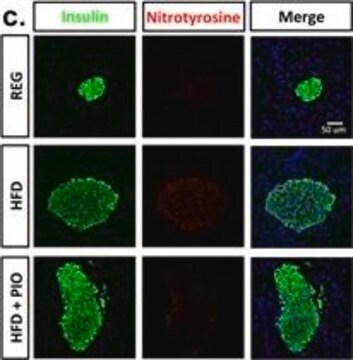06-284
Anti-Nitrotyrosine Antibody
Upstate®, from rabbit
Synonym(s):
Anti-Nitrotyrosine, Detection Antibody, Nitrotyrosine Detection Antibody
About This Item
Recommended Products
biological source
rabbit
Quality Level
antibody form
affinity purified immunoglobulin
antibody product type
primary antibodies
clone
polyclonal
species reactivity (predicted by homology)
all
manufacturer/tradename
Upstate®
technique(s)
immunocytochemistry: suitable
immunohistochemistry: suitable
immunoprecipitation (IP): suitable
western blot: suitable
isotype
IgG
shipped in
dry ice
General description
Specificity
Immunogen
Application
- Immunocytochemistry Analysis: A 1:200 dilution from a representative lot detected in fixed and permeabilized A-431 cells treated with 5mM peroxynitrite for 15 minutes.
- Immunohistochemistry Applications: A representative lot detected Nitrotyrosine in human colon cancer, human Alzheimer′s brain and human diabetic kidney tissue sections.
- Note: Actual optimal working dilutions must be determined by end user as specimens, and experimental conditions may vary with the end user
Neurotransmitters & Receptors
Neurodegenerative Diseases
Quality
Target description
Physical form
Storage and Stability
Legal Information
Disclaimer
Not finding the right product?
Try our Product Selector Tool.
Storage Class
12 - Non Combustible Liquids
wgk_germany
WGK 2
flash_point_f
Not applicable
flash_point_c
Not applicable
Certificates of Analysis (COA)
Search for Certificates of Analysis (COA) by entering the products Lot/Batch Number. Lot and Batch Numbers can be found on a product’s label following the words ‘Lot’ or ‘Batch’.
Already Own This Product?
Find documentation for the products that you have recently purchased in the Document Library.
Our team of scientists has experience in all areas of research including Life Science, Material Science, Chemical Synthesis, Chromatography, Analytical and many others.
Contact Technical Service







